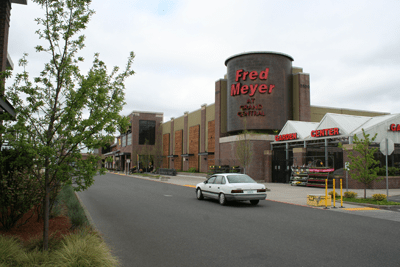How do you build a flourishing retail center in the middle of a recession? According to Mert Meeker, president of MBM Properties Inc. and exclusive leasing agent for Killian Pacific’s Grand Central shopping center, the key is three-fold:
“Identify a need, and as you move to fill that need, take input from the community,” said Meeker, while noting that it’s also important to choose the tenant mix carefully.
These three concepts have contributed to the success of Grand Central, according to Meeker, which he said has had zero tenant turnover since opening in 2008 and very little vacant space. The lack of tenant turnover, he explained, is a “testimony to the project, the tenants themselves and the sense of community the project created.”
Filling the void
Before it was ever home to a bustling shopping center, the 14.5 acres of land at Grand Boulevard and SR-14 on which Grand Central sits once contained housing for the Kaiser Shipyards. Eventually the property would transition to an industrial use as a manufacturing facility for Jantzen Swimwear. The site then went unutilized for years following the closure of the Jantzen facility. That is, until Killian Pacific acquired it.
Philip Bretsch, acquisitions and development manager for Killian Pacific, said development began after identifying the need for “a quality shopping experience, with a strong grocery/retail anchor like Fred Meyer, to serve the southwestern potion of Vancouver.”
More than 230,000 residents live in the area served by Grand Central. Along with a large population looking for groceries and services, said Meeker, the site has good visibility to the highway and is easily accessed from downtown Vancouver and nearby residential neighborhoods.
Engaging the community
Bretsch said that Killian Pacific, which has developed several other large shopping centers in Clark County, doesn’t follow a cookie-cutter model.
“Each project seems to have its own nuances, has to be fit to place, and enhance community in its own way,” he said.
To discover those nuances, Killian Pacific held a number of meetings throughout the development planning process. The company also solicited input from key neighborhood associations and major employers in the area, such as Columbia Machine.
This process, explained Meeker, enabled Killian Pacific to “create something that the community embraced.”
In these conversations, Killian Pacific learned things that helped guide the design. For example, residents stated that they didn’t want the 139,000-square-foot anchor tenant building to look like a massive concrete fortress. Instead, said Meeker, the design incorporates different patterns, materials, shapes and paint colors to break the scale down.
Equal attention was paid to configuring outlying parcels, such as “The Village” – a cluster of three buildings that house Lapellah Restaurant & Bar, Thatcher’s Coffee and Cotton Babies. These buildings are arranged in a close, triangular, pedestrian-friendly way. For example, there is an outdoor patio between Lapellah’s and Thatcher’s, and parking spaces are angled to provide a “main street” ambiance.
The arrangement, noted Meeker, “establishes a pattern for walking traffic and a sense of place.”
Choosing the tenant team
“Finding the right mix of tenants is critical to provide the best shopping experience for the customer,” said Bretsch.
At Grand Central, developers focused on local or largely independent retailers instead of national franchises. With its local roots, selecting Fred Meyer as an anchor tenant was a natural choice, Meeker said. Choosing other tenants, he added, involved deciding on major categories, such as food, traditional retail and personal services. Next, developers zeroed in on subcategories, such as pizza, coffee and full-service restaurant. Finally, he said, they picked the ones with the most potential for success by interviewing the owners and examining their business plans and financial records.
Meeker said Killian Pacific chose tenants who are unique to the Portland/Vancouver area and can generate a regional draw. For example,
- Grand Central’s Cotton Babies is the only such store west of the Mississippi;
- The Fred Meyer is 2.5 times larger than the typical Fred Meyer store;
- Many stylists at Estilo Hair have Toni and Guy Academy certifications;
- Willows Lifestyle Boutique is one of the Southwest Washington’s only high-end apparel boutiques.
“Willows is an absolute leader in fashion in Vancouver,” said Lavonne Morrill, whose Estilo Salon moved to Grand Central from Portland in 2011. “They come here, that speaks volumes. You know you’re on to something to special.”
Build [the right thing] and they will come
Meeker reported that “Fred Meyer says it is by far the most successful design they have,” with traffic through the store averaging about 22,000 customer visits per week.
According to Amy O’Hara, who owns When the Shoe Fits with her husband Alan, they really weren’t interested in expanding when approached as a potential tenant for Grand Central. However, she said, when they toured the shopping center, “the vibe was electric – the parking lot was packed, teaming with a savvy professional energy that we were really drawn to.”
They opened their Grand Central store (their third location) in October 2011, and she said business continues to increase. One surprise, she said was how many people came to Grand Central from Portland. In response, she said they have done more marketing in Oregon using TV, radio and cable, and are “infusing the store with a hipper product” compared to their suburban locations.
Morrill reported that Estilo Salon is “experiencing more than satisfactory revenue growth,” and her staff has increased from six to 12 in just over a year. Like O’Hara, she said almost half her salon’s clients come from Portland.
“We hear how pleasantly surprised they are to see such an upscale shopping center, and they try other businesses that are here,” Morrill noted.
“We’re changing public perception of Vancouver one client at a time,” added Morrill.




